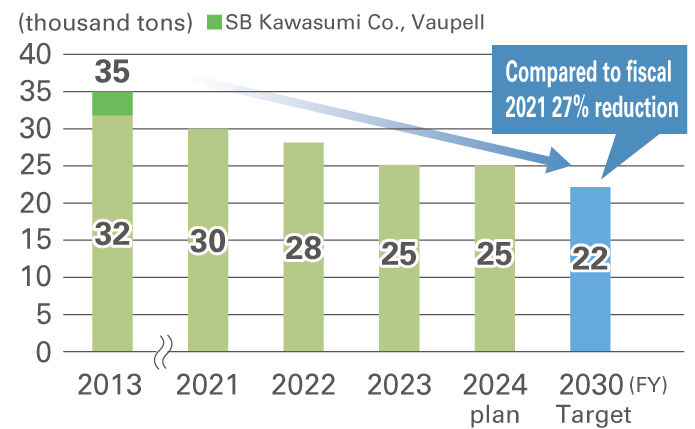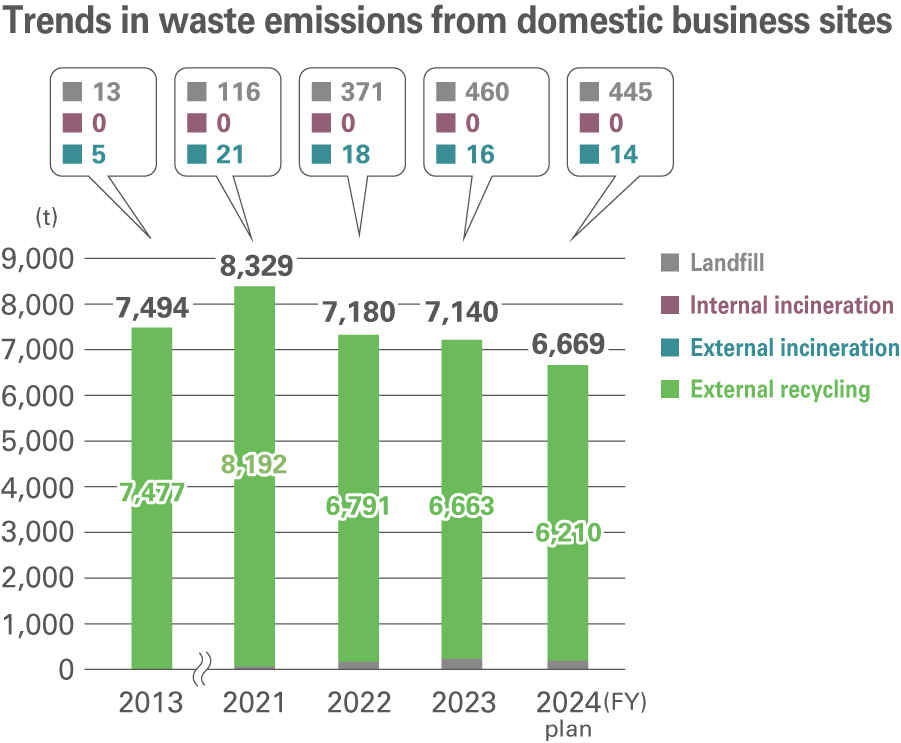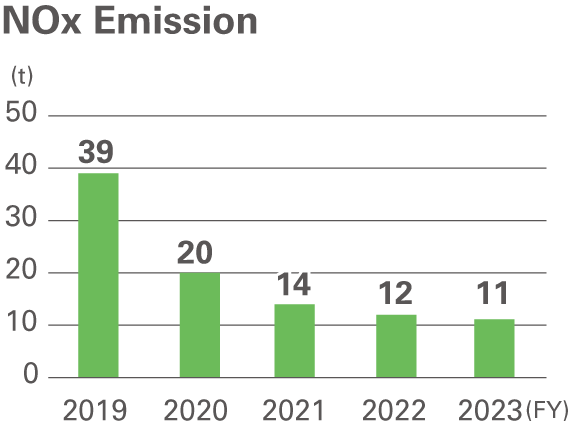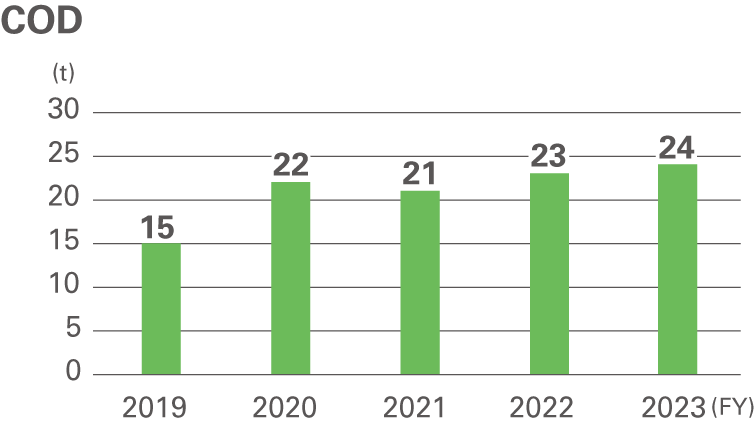Policy and Basic Approach
Environmental Policy
Our Group has established the Environmental Policy as a policy related to environmental issues pertaining to our Group (including resource circulation, waste reduction and pollution prevention). Our Group's Environmental Policy is described on the following page.
Structure (Governance)
The structure for supervision and management of environmental issues pertaining to our Group (including resource circulation, waste reduction and pollution prevention) is described on the following page.
Risk Management
The identification, assessment, and management of risks and opportunities related to environmental issues pertaining to our (including resource circulation, waste reduction and pollution prevention) are carried out in accordance with the risk management system and risk management process described on the following page.
Metrics and Targets
Promoting Reduction of Material Loss
Our group is working to increase the efficient use of resources ratio, because it regards the reduction of environmental impacts as an opportunity to improve profitability. The increase in material loss, including both waste and valuable materials, leads to an increase in resource losses and in the loads involved in processing. Through MFCA initiatives, the Group is promoting load reduction through the reduction of material loss and the improvement of effective use of raw materials.
In fiscal 2023, production volume decreased slightly, and the amount of material loss also decreased in tandem with production volume. We will continue to promote effective use of resources and reduction of waste in fiscal 2024 by identifying losses and promoting reduction measures through MFCA*1 activities at each business site.
- *1: See the glossary.
Entire the Group of Sumitomo Bakelite Co., Ltd.

|
|
Main Initiatives
Waste Management
We believe it is important for our Group to adhere to environmental laws and regulations, and conduct business activities that minimize our environmental impact. For waste, we have established rules for on-site verification of waste disposal contractors in accordance with the Waste Management and Public Cleansing Act, and we continue to manage and quantify the amount of waste generated based on the issuance of manifests. Based on the above, we promote minimization of material loss and effective utilization (reuse/recycling), and promote activities to reduce material loss, including valuable materials.
We also consider it important to work to reduce the environmental impact of society through our products and services as stated in our Environmental Vision for 2050 (Net Zero) “02. Contribute to reducing CO2, including along supply chains”: “Develop products that factor in reducing CO2 throughout their life cycle.” In this context, weight (volume) reduction, longer service life, recycling, and mono-material design are also initiatives by which we reduce waste in the supply chain as well as CO2 emissions.
Meanwhile, we have been systematically disposing of polychlorinated biphenyl (PCB) waste in accordance with the Act on Special Measures concerning Promotion of Proper Treatment of PCB Wastes. Disposal of high-concentration PCBs has been carried out systematically in accordance with the capabilities of the Japan Environmental Safety Corporation (JESCO) in each region, with a view to complete disposal during fiscal 2024. Planned disposal of low-concentration PCBs has also been under way since fiscal 2017, and we are moving forward to complete disposal by the legally mandated deadline.
Changes in the type of treatment for waste material at domestic business sites are shown in the graph on the right. The amount of waste treated using a combination of landfills and simple incinerators did drop to 18 t in fiscal 2013 through reduction measures conducted at each site, but subsequent restrictions to exports of waste plastics overseas and the lack of capacity at recyclers in Japan has led to a gradual increase.

- * Figures include the total of landfill waste, internally incinerated waste, and externally incinerated waste.
Initiatives for Resource Circulation
Marine plastics
When it comes to the problem of marine plastics, we are moving ahead with activities to contribute to reducing plastic marine waste via a number of initiatives based on the Japanese government’s Plastic Resource Recycling Strategy. These initiatives include managing the raw materials used and the plastic products we manufacture, promoting the recycling of said products, and developing new products.
We are currently taking part in the Clean Ocean Material Alliance (CLOMA), which was established by a broad range of business operators related to supply chains for plastic products, including those in the chemical industry and distribution/retail industries, with the goal of forming cross-industry partnerships. Through this, we are working to address a variety of challenges by aiming to curb plastic waste across our supply chain as a whole and promoting resource circulation via 3R activities for plastic products.
Recycling
Our Group promotes recycling as a means to make efficient use of resources. This recycling includes the recovery and recycling of phenol from waste liquid produced by phenolic resin reactions during the product production process, fine grinding of offcuts from phenolic laminated sheets and decorative melamine resin decorative laminates for use as a filler in phenolic molding compounds reuse of molded parts by-products (sprues and runners) as raw material for molding materials, as well as reuse of excess sludge from activated sludge effluent treatment equipment as compost (organic fertilizer).
Renewable raw materials
Our Group has been using inedible plant-derived raw materials as renewable raw materials, primarily of phenolic resins (cashew nutshell oil, rosin (pine resin), wood flour, etc.) and molding compounds. They account for about 2.7% of all raw materials used.
In fiscal 2022 we added to our lineup packaging films for food and pharmaceutical products made from renewable biomass materials, and in April 2023 we added eco-friendly phenolic molding compounds using plant-derived lignin.
Emissions into the Atmosphere
The Group’s business sites in Japan have been promoting a shift of boiler fuel from heavy oil to city gas since fiscal 2004. With the completion of the fuel conversion from heavy oil at the Shizuoka Plant in mid-2019, SOx emissions for the Group as a whole have been further reduced. We were able to greatly decrease emissions of NOx due to a decrease in the nitrogen content of city gas and stabilization of combustion conditions.
Heavy oil is still in use at some business sites in regions where city gas supplies are unavailable, and we are working to optimize the combustion conditions and keep both emissions of SOx and soot and dust down at low levels.
The switch to city gas is also currently being considered to stem the use of heavy oil.

|

|

|
- * NOx emissions are calculated for all domestic business sites covered in the Editorial Policy of the Integrated Report, which are required for measuring NOx emissions by laws and regulations.
Emissions into the Hydrosphere
Effluent discharged from plants includes pollutants, which are categorized into industrial and household sewage. Treatment facilities, such as high-concentration phenol recovery equipment and activated sludge treatment equipment, and surveillance systems for constant monitoring are in place to ensure compliance with environmental standards and laws and regulations at the national and local government levels. Additionally, risk assessments are conducted on leakages into rainwater that also includes cooling water to prevent sudden and unexpected increases in environmental impacts.
COD load, a typical indicator of water quality, increased only slightly from the previous year in fiscal 2023, and emissions for the whole Company in Japan remain at low levels from a long-term perspective.

- * COD Load is calculated for all domestic business sites covered in the Editorial Policy of the Integrated Report, which are required for measuring pollutant laad by laws and regulations.
Response to Soil/Underground Water Pollution
Our Group carries out risk assessments relating to leakage of chemical substances at all of our business sites, and we promote both the development and implementation of preventive frameworks. At the same time, when contamination caused by past leakage accidents is confirmed, we actively undertake voluntary surveys and institute countermeasures in order to prevent the environmental impact and health damage from spreading.
We did not suffer any severe leakage accidents in fiscal 2024.
Results of Soil and Groundwater Studies, Related Actions, and Monitoring
| Site | Results of investigation | Countermeasures and monitoring results |
|---|---|---|
| Amagasaki Plant | Lead was detected by soil content sampling in 2009 and 2010 (max. 500 mg/kg, whereas the standard is 150 mg/kg). No groundwater contamination was detected. | Heavy metals exceeding the standard values of the Soil Contamination Countermeasures Act were detected at the business sites on the left. Monitoring of the groundwater is conducted at these sites every year and their contamination levels have been confirmed to be below standard values. |
| Akita Sumitomo Bakelite Co., Ltd. | Lead was detected by soil elution sampling in 2005 (max. 0.032mg/L, whereas the standard is 0.01 mg/L). No groundwater contamination was detected. | |
| Yamaroku Kasei Industry Co., Ltd. | In January 2016, 1,4-Dioxane in excess of the standard concentrations was detected in the company’s cooling water effluent, with concentrations of a similar amount confirmed in well water drawn from on the premises that had been used. In consultation with the government, the plant stopped drawing water and switched to a closed water cooling system. The company has no history of using the substance in question. | The company cooperates with an ongoing monitoring survey of the groundwater quality that is regularly conducted by Osaka Prefecture, and also continues to perform independent examinations as well. The latest measurement results were 7.3mg/L (standard value of 0.05mg/L). |

